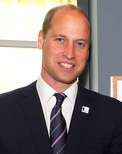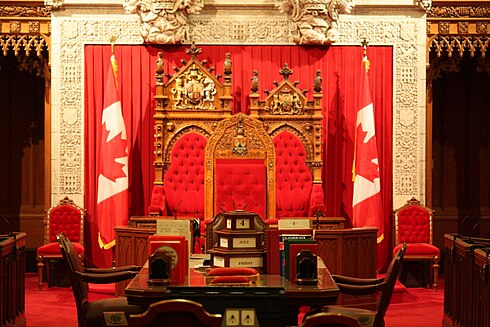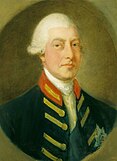
A | B | C | D | E | F | G | H | CH | I | J | K | L | M | N | O | P | Q | R | S | T | U | V | W | X | Y | Z | 0 | 1 | 2 | 3 | 4 | 5 | 6 | 7 | 8 | 9
This article may be too long to read and navigate comfortably. (April 2024) |
| King of Canada | |
|---|---|
| Roi du Canada | |
Federal | |
 | |
| Incumbent | |
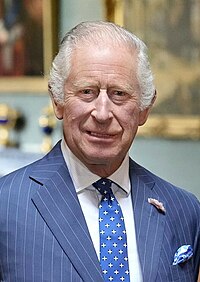 | |
| Charles III since 8 September 2022 | |
| Details | |
| Style | His Majesty |
| Heir apparent | William, Prince of Wales[1] |
| Website | canada.ca/monarchy-crown |
 |
|---|
The monarchy of Canada is Canada's form of government embodied by the Canadian sovereign and head of state. It is one of the key components of Canadian sovereignty and sits at the core of Canada's constitutional federal structure and Westminster-style parliamentary democracy.[6] The monarchy is the foundation of the executive (King-in-Council), legislative (King-in-Parliament), and judicial (King-on-the-Bench) branches of both federal and provincial jurisdictions.[10] The current monarch is King Charles III, who has reigned since 8 September 2022.[17]
Although the sovereign is shared with 14 other independent countries within the Commonwealth of Nations, each country's monarchy is separate and legally distinct.[22] As a result, the current monarch is officially titled the King of Canada and, in this capacity, he and other members of the royal family undertake public and private functions domestically and abroad as representatives of Canada. However, the monarch is the only member of the royal family with any constitutional role. The monarch lives in the United Kingdom and, while several powers are the sovereign's alone,[23] most of the royal governmental and ceremonial duties in Canada are carried out by the monarch's representative, the governor general of Canada.[27] In each of Canada's provinces, the monarchy is represented by a lieutenant governor. As territories fall under the federal jurisdiction, they each have a commissioner, rather than a lieutenant governor, who represents the federal Crown-in-Council directly.
All executive authority is vested in the sovereign, so the monarch's consent is necessary for letters patent and orders-in-council to have legal effect. As well, the monarch is part of the Parliament of Canada, so royal assent is required to allow for bills to become law. While the power for these acts stems from the Canadian people through the constitutional conventions of democracy,[28] executive authority remains vested in the Crown and is only entrusted by the sovereign to the government on behalf of the people. This underlines the Crown's role in safeguarding the rights, freedoms, and democratic system of government of Canadians, reinforcing the fact that "governments are the servants of the people and not the reverse".[29][30] Thus, within Canada's constitutional monarchy the sovereign's direct participation in any of these areas of governance is normally limited, with the sovereign typically exercising executive authority only with the advice and consent of the Cabinet of Canada, and the sovereign's legislative and judicial responsibilities largely carried out through the Parliament of Canada as well as judges and justices of the peace.[29] There are, though, cases where the sovereign or their representative would have a duty to act directly and independently under the doctrine of necessity to prevent genuinely unconstitutional acts.[31][32] In these respects, the sovereign and his viceroys are custodians of the Crown's reserve powers and represent the "power of the people above government and political parties".[33][34] Put another way, the Crown functions as the guarantor of Canada's continuous and stable governance and as a nonpartisan safeguard against the abuse of power.[37]
Canada has been described as "one of the oldest continuing monarchies in the world" of today.[19][38] Parts of what is now Canada have been under a monarchy since as early as the 15th century as a result of colonial settlement and often competing claims made on territory in the name of the English (and later British) and French crowns.[51] Monarchical government has developed as the result of colonization by French and British empires competing for territory in North America and a corresponding succession of French and British sovereigns reigning over New France and British America, respectively. As a result of the conquest of New France, claims by French monarchs were extinguished and what became British North America came under the hegemony of the British monarchy which ultimately evolved into the Canadian monarchy of today.[54] With the exception of Newfoundland from 1649 to 1660, no part of what is now Canada has been a republic or part of a republic;[55] though, there have been isolated calls for the country to become one. The Crown, however, is considered to be "entrenched" into the governmental framework.[59] The institution that is Canada's system of constitutional monarchy is sometimes colloquially referred to as the Maple Crown[n 1] or Crown of Maples,[63] Canada having developed a "recognizably Canadian brand of monarchy".[64]
Though not part of the Canadian monarchy, either past or present, Canada has an even older tradition of hereditary chieftainship in some First Nations, which has been likened to non-sovereign monarchy and today exists in parallel with the Canadian Crown and individual band governments. All three entities are components of the nation-to-nation relationship between the Crown and First Nations in upholding treaty rights and obligations developed over the centuries.[citation needed]
International and domestic aspects
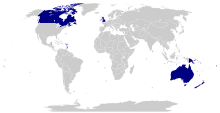
The 15 realms of which King Charles III is the reigning sovereign
The monarch is shared in a personal union with 14 other Commonwealth realms within the 56-member Commonwealth of Nations. As he resides[65][66][67][68] in the United Kingdom, viceroys (the governor general of Canada in the federal sphere and a lieutenant governor in each province) represent the sovereign in Canada and are able to carry out most of the royal governmental duties, even when the monarch is in the country[n 2] Nevertheless, the monarch can carry out Canadian constitutional and ceremonial duties abroad.[n 3][n 4]
The evolution of the role of the governor general from being both a representative of the sovereign and an "agent of the British government" who " in matters deemed to be of 'imperial' concern... acted on the instructions of the British Colonial Office"[73] to being solely a representative of the monarch developed with a rise in Canadian nationalism following the end of the First World War culminating in the passage of the Statute of Westminster in 1931.[74][75] Since then, the Crown has had both a shared and a separate character: the sovereign's role as monarch of Canada has been distinct from his or her position as monarch of any other realm,[n 3][79] including the United Kingdom.[n 5][85] Only Canadian federal ministers of the Crown may advise the sovereign on any and all matters of the Canadian state,[n 6][91] of which the sovereign, when not in Canada, is kept abreast by weekly communications with the federal viceroy.[92] The monarchy thus ceased to be an exclusively British institution and, in Canada, became a Canadian,[96] or "domesticated",[97] establishment, though it is still often denoted as "British" in both legal and common language,[46] for reasons historical, political, and of convenience.

This division is illustrated in a number of ways: The sovereign, for example, holds a unique Canadian title and,[98] when he and other members of the royal family are acting in public specifically as representatives of Canada, they use, where possible, Canadian symbols, including the country's national flag, unique royal symbols, armed forces uniforms,[103] and the like, as well as Canadian Forces aircraft or other Canadian-owned vehicles for travel.[104] Once in Canadian airspace, or arrived at a Canadian event taking place abroad, the Canadian secretary to the King, officers of the Royal Canadian Mounted Police (RCMP), and other Canadian officials will take over from whichever of their other realms' counterparts were previously escorting the King or other member of the royal family.[104][105]
The sovereign similarly only draws from Canadian funds for support in the performance of his duties when in Canada or acting as King of Canada abroad; Canadians do not pay any money to the King or any other member of the royal family, either towards personal income or to support royal residences outside of Canada.[106][107]
There are five aspects to the monarchy of Canada: constitutional (such as the use of the royal prerogative in summoning and dissolving parliament, granting royal assent), national (delivering the Speech from the Throne and the Royal Christmas Message, distributing honours, decorations, and medals, and partaking in Remembrance Day ceremonies), international (the monarch being head of state in other Commonwealth realms, and being the head of the Commonwealth), religious (the words by the grace of God in the monarch's title, the Act of Settlement, 1701, requiring the sovereign to be Anglican, and the monarch encouraging people "to tolerate, accept, and understand cultures, beliefs, and faiths different from our own"), and the welfare and service monarchy (seen in members of the royal family founding charities and supporting others, fundraising for charity, and giving royal patronage to civil and military organizations).[108]
Succession and regency
As in the other Commonwealth realms, the current heir apparent to the Canadian throne is William, Prince of Wales, who is followed in the line of succession by his eldest child, Prince George.
Demise of the Crown and accession
Upon the death of the monarch, there is an immediate and automatic succession by the late sovereign's heir;[111] hence the phrase, "the King is dead. Long live the King".[112][113] No confirmation or further ceremony is necessary. The federal cabinet and civil service follow the Manual of Official Procedure of the Government of Canada in carrying out various formalities around the transition.[114]
By custom, the accession of a new monarch is publicly proclaimed by the governor general-in-council, who meet at Rideau Hall immediately upon the previous monarch's death.[114] Since the adoption of the Statute of Westminster it has been considered "constitutionally inappropriate" for Canada's accession proclamations to be approved by a British order-in-council,[77] as the monarch has, since then, assumed the Canadian throne according to Canadian law. For the accession of Charles III, the first since the creation of the Canadian Heraldic Authority in 1989, the Chief Herald read the royal proclamation aloud. If Parliament is in session, the Prime Minister will announce the demise of the Crown there and move for a joint address of sympathy and loyalty to the new monarch.[114]
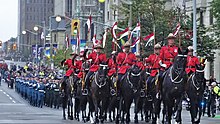
A period of mourning also follows, during which portraits of the recently deceased monarch are draped with black fabric and staff at government houses wear black armbands. The Manual of Official Procedure of the Government of Canada states the prime minister is responsible for convening Parliament, tabling a resolution of loyalty and condolence from Parliament to the new monarch, and arranging for the motion to be seconded by the leader of the official opposition.[109][115] The prime minister will then move to adjourn Parliament.[109][115] The Canadian Broadcasting Corporation keeps a regularly updated plan for a "broadcast of national importance", announcing the demise of a sovereign and covering the aftermath, during which all regular programming and advertising is cancelled and on-call commentators contribute to a 24-hour news mode.[109] As funerals for Canada's sovereigns, as well as for their consorts, take place in the United Kingdom,[116] commemoration services are conducted by the federal and provincial governments across Canada.[116][117] Such ceremonies may also be held for other recently deceased members of the royal family. The day of the sovereign's funeral is likely to be a federal holiday.[109][118]
The new monarch is crowned in the United Kingdom in an ancient ritual but one not necessary for a sovereign to reign.[n 7] Under the federal Interpretation Act,[114] officials who hold a federal office under the Crown are not affected by the death of the monarch, nor are they required to take the Oath of Allegiance again.[119] In some provinces, though, those holding Crown offices must swear the Oath to the new sovereign.[120] All references in federal legislation to previous monarchs, whether in the masculine (e.g. His Majesty) or feminine (e.g. The Queen), continue to mean the reigning sovereign of Canada, regardless of his or her gender.[121] This is because, in common law, the Crown never dies. After an individual accedes to the throne, he or she usually continues to reign until death.[n 8]
Legal aspects of succession
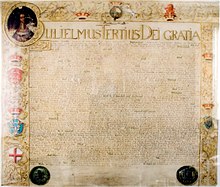
The relationship between the Commonwealth realms is such that any change to the rules of succession to their respective crowns requires the unanimous consent of all the realms. Succession is governed by statutes, such as the Bill of Rights, 1689, the Act of Settlement, 1701, and the Acts of Union, 1707.

King Edward VIII abdicated in 1936 and any possible future descendants of his were excluded from the line of succession.[122] The British government at the time, wishing for speed so as to avoid embarrassing debate in Dominion parliaments, suggested that the governments of the Dominions of the British Commonwealth—then Australia, New Zealand, the Irish Free State, the Union of South Africa, and Canada—regard whoever was monarch of the UK to automatically be monarch of their respective Dominion. As with the other Dominion governments, the Canadian Cabinet, headed by Prime Minister William Lyon Mackenzie King, refused to accept the idea and stressed that the laws of succession were part of Canadian law and, as the Statute of Westminster 1931 disallowed the UK from legislating for Canada, including in relation to succession,[123] altering them required Canada's request and consent to the British legislation (His Majesty's Declaration of Abdication Act, 1936) becoming part of Canadian law.[124] Sir Maurice Gwyer, first parliamentary counsel in the UK, reflected this position, stating the Act of Settlement was a part of the law in each Dominion.[124] Thus, Order-in-Council P.C. 3144[125] was issued, expressing the Cabinet's request and consent for His Majesty's Declaration of Abdication Act, 1936, to become part of the laws of Canada and the Succession to the Throne Act, 1937, gave parliamentary ratification to that action, together bringing the Act of Settlement and Royal Marriages Act, 1772, into Canadian law.[126][127] The latter was deemed by the Cabinet in 1947 to be part of Canadian law.[n 9][128] The Department of External Affairs included all succession-related laws in its list of acts within Canadian law.
The Supreme Court of Canada declared unanimously in the 1981 Patriation Reference that the Bill of Rights, 1689, is "undoubtedly in force as part of the law of Canada".[130][131] Furthermore, in O'Donohue v. Canada (2003) the Ontario Superior Court of Justice found that the Act of Settlement, 1701, is "part of the laws of Canada" and the rules of succession are "by necessity incorporated into the Constitution of Canada".[132] Another ruling of the Ontario Superior Court, in 2014, echoed the 2003 case, stating that the Act of Settlement "is an imperial statute which ultimately became part of the law of Canada."[133] Upon dismissing appeal of that case, the Court of Appeal of Ontario stated "he rules of succession are a part of the fabric of the constitution of Canada and incorporated into it".[134]
In a meeting of the Special Joint Committee on the Constitution during the process of patriating the Canadian constitution in 1981, John Munro asked then-Minister of Justice Jean Chrétien about the "selective omissions" of the Succession to the Throne Act, 1937, the Demise of the Crown Act, 1901, the Seals Act, the Governor General's Act, and the Royal Style and Titles Act, 1953, from the schedule to the Constitution Act, 1982. In response, Chrétien asserted that the schedule to the Constitution Act, 1982, was not exhaustive, outlining that section 52(2) of the Constitution Act, 1982, says "he Constitution of Canada includes the acts and orders referred to the schedule" and "hen you use the word 'includes' it means that if ever there is another thing related to the Canadian constitution as part of it, should have been there, or might have been there, it is covered. So we do not have to renumerate the ones that you are mentioning."[135] In the same meeting, Deputy Attorney General Barry Strayer stated: "Clause 52(2) is not an exhaustive definition of the Constitution of Canada so that while we have certain things listed in the schedule which are clearly part of the constitution, that does not mean that there are not other things which are part of the constitution is not an exhaustive list."[135]
The throne of Canada (left) and throne for the royal consort (right)—both commissioned in 1878—behind the speaker's chair in the Senate
|
The sovereign's throne (left) and royal consort's throne (right) behind the speaker's chair—all made in 2017—in the temporary Senate chamber
|
Leslie Zines claimed in the 1991 publication, Constitutional Change in the Commonwealth, that, though the succession to Canada's throne was outlined by common law and the Act of Settlement, 1701, these were not part of the Canadian constitution, which "does not contain rules for succession to the throne."[136] Richard Toporoski, writing three years later for the Monarchist League of Canada, stated, "there is no existing provision in our law, other than the Act of Settlement, 1701, that provides that the king or queen of Canada shall be the same person as the king or queen of the United Kingdom. If the British law were to be changed and we did not change our law the person provided for in the new law would become king or queen in at least some realms of the Commonwealth; Canada would continue on with the person who would have become monarch under the previous law."[137]
Canada, with the other Commonwealth realms, committed to the 2011 Perth Agreement, which proposed changes to the rules governing succession to remove male preference and removal of disqualification arising from marriage to a Roman Catholic. As a result, the Canadian Parliament passed the Succession to the Throne Act, 2013, which gave the country's assent to the Succession to the Crown Bill, at that time proceeding in the Parliament of the United Kingdom. In dismissing a challenge to the law on the basis that a change to the succession in Canada would require unanimous consent of all provinces under section 41(a) of the Constitution Act, 1982, Quebec Superior Court Justice Claude Bouchard ruled that Canada "did not have to change its laws nor its constitution for the British royal succession rules to be amended and effective" and constitutional convention committed Canada to having a line of succession symmetrical to those of other Commonwealth realms.[138][139] The ruling was upheld by the Quebec Court of Appeal.[140] The Supreme Court of Canada declined to hear an appeal in April 2020.[141]
Constitutional scholar Philippe Lagassé argues that, in light of the Succession to the Throne Act, 2013, and court rulings upholding that law, section 41(a) of the Constitution Act, 1982, which requires a constitutional amendment passed with the unanimous consent of the provinces, applies only to the "office of the Queen", but not who holds that office, and that therefore "ending the principle of symmetry with the United Kingdom can be done with the general amending procedure, or even by Parliament alone under section 44 of the Constitution Act, 1982."[141][142]
Ted McWhinney, another constitutional scholar, argued that a then-future government of Canada could begin a process of phasing out the monarchy after the death of Elizabeth II "quietly and without fanfare by simply failing legally to proclaim any successor to the Queen in relation to Canada". This would, he claimed, be a way of bypassing the need for a constitutional amendment that would require unanimous consent by the federal Parliament and all the provincial legislatures.[143] However, Ian Holloway, Dean of Law at the University of Western Ontario, criticized McWhinney's proposal for its ignorance of provincial input and opined that its implementation "would be contrary to the plain purpose of those who framed our system of government."[144]
Certain aspects of the succession rules have been challenged in the courts. For example, under the provisions of the Bill of Rights, 1689, and the Act of Settlement, 1701, Catholics are barred from succeeding to the throne; this prohibition has been upheld twice by Canadian courts, once in 2003 and again in 2014.[149] Legal scholar Christopher Cornell of the SMU Dedman School of Law concluded "that the prohibition on the Canadian Monarch being Catholic, while discriminatory, is perfectly-if not fundamentally-constitutional" and that if the prohibition is "to be changed or removed it will have to be accomplished politically and legislatively through another multilateral agreement similar to the Perth Agreement rather than judicially through the courts."[150]
Regency
Canada has no laws allowing for a regency, should the sovereign be a minor or debilitated;[92] none have been passed by the Canadian Parliament and it was made clear by successive cabinets since 1937 that the United Kingdom's Regency Act had no applicability to Canada,[92] as the Canadian Cabinet had not requested otherwise when the act was passed that year and again in 1943 and 1953. As the Letters Patent, 1947, issued by King George VI permit the governor general of Canada to exercise almost all of the monarch's powers in respect of Canada, the viceroy is expected to continue to act as the personal representative of the monarch, and not any regent, even if the monarch is a child or incapacitated.[153]
This has led to the question of whether the governor general has the ability to remove themselves and appoint their viceregal successor in the monarch's name. While Lagassé argued that appears to be the case,[142] both the Canadian Manual of Official Procedures, published in 1968, and the Privy Council Office took the opposite opinion.[154][155] Lagassé and Patrick Baud claimed changes could be made to regulations to allow a governor general to appoint the next governor general;[156] Christopher McCreery, however, criticised the theory, arguing it is impractical to suggest that a governor general would remove him or herself on ministerial advice,[157] with the consequence that, if a prolonged regency occurred, it would remove one of the checks and balances in the constitution.[158] The intent expressed whenever the matter of regency came up among Commonwealth realm heads of government was that the relevant parliament (other than the United Kingdom's) would pass a bill if the need for a regency arose and the pertinent governor-general would already be empowered to grant royal assent to it.[159] The governor general appointing their successor is not a power that has been utilized to date.[142]
Foreign visits
The following state and official visits to foreign countries have been made by the monarch as the sovereign of Canada (sometimes representing other realms on the same visit):
| Visit to | Date | Monarch of Canada | Received by | Type |
|---|---|---|---|---|
| 26 July 1936 | King Edward VIII | President Albert Lebrun | Official[163] | |
| 7–11 June 1939 | King George VI | President Franklin D. Roosevelt | State[164][165][166] | |
| 17 October 1957 | Queen Elizabeth II | President Dwight D. Eisenhower | State[170] | |
| 26 June 1959 | Official[171][172] | |||
| 6 July 1959 | Governor William Stratton | State[175] | ||
| 6 June 1984 | President François Mitterrand | Official[179] | ||
| 1994 | Official[172][178] | |||
| 6 June 2004 | President Jacques Chirac | Official[180][172] | ||
| 9 April 2007 | Prime Minister Dominique de Villepin | Official[181] | ||
| 6 July 2010 | Governor David Paterson | Official[166][182] |
Federal and provincial aspects
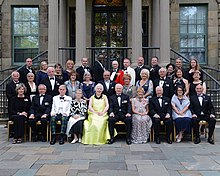
The origins of Canadian sovereignty lie in the early 17th century, during which time the monarch in England fought with parliament there over who had ultimate authority, culminating in the Glorious Revolution in 1688 and the subsequent Bill of Rights, 1689, which, as mentioned elsewhere in this article, is today part of Canadian constitutional law. This brought to Canada the British notion of the supremacy of parliament—of which the monarch is a part—and it was carried into each of the provinces upon the implementation of responsible government. That, however, was superseded when the Charter of Rights and Freedoms (within the Constitution Act, 1982) introduced into Canada the American idea of the supremacy of the law.[183] Still, the King remains the sovereign of Canada.[n 10][185]
Canada's monarchy was established at Confederation, when its executive government and authority were declared, in section 9 of the Constitution Act, 1867, to continue and be vested in the monarch. Placing such power, along with legislative power, with the tangible, living Queen, rather than the abstract and inanimate Crown, was a deliberate choice by the framers of the constitution.[186] Still, the Crown is the foundation of the country[187][188] as "the very centre of constitution and democracy."[187] Although Canada is a federation, the Canadian monarchy is unitary throughout all jurisdictions in the country,[189] the sovereignty of the different administrations being passed on through the overreaching Crown itself as a part of the executive, legislative, and judicial operations in each of the federal and provincial spheres[190] and the headship of state being a part of all equally.[189] The Crown thus links the various governments into a federal state,[8] while it is simultaneously also "divided" into 11 legal jurisdictions, or 11 "crowns"—one federal and 10 provincial[191]—with the monarch taking on a distinct legal persona in each.[n 11][n 12] As such, the constitution instructs that any change to the position of the monarch or his or her representatives in Canada requires the consent of the Senate, the House of Commons, and the legislative assemblies of all the provinces.[194] The Crown, being shared and balanced,[188] provides the bedrock upon which all of Canada's different regions and peoples can live together peacefully[195] and was said by David E. Smith, in 2017, to be the "keystone of the constitutional architecture" of Canada.[196]
Zdroj:https://en.wikipedia.org?pojem=Monarchy_of_CanadaText je dostupný za podmienok Creative Commons Attribution/Share-Alike License 3.0 Unported; prípadne za ďalších podmienok. Podrobnejšie informácie nájdete na stránke Podmienky použitia.
Antropológia
Aplikované vedy
Bibliometria
Dejiny vedy
Encyklopédie
Filozofia vedy
Forenzné vedy
Humanitné vedy
Knižničná veda
Kryogenika
Kryptológia
Kulturológia
Literárna veda
Medzidisciplinárne oblasti
Metódy kvantitatívnej analýzy
Metavedy
Metodika
Text je dostupný za podmienok Creative
Commons Attribution/Share-Alike License 3.0 Unported; prípadne za ďalších
podmienok.
Podrobnejšie informácie nájdete na stránke Podmienky
použitia.
www.astronomia.sk | www.biologia.sk | www.botanika.sk | www.dejiny.sk | www.economy.sk | www.elektrotechnika.sk | www.estetika.sk | www.farmakologia.sk | www.filozofia.sk | Fyzika | www.futurologia.sk | www.genetika.sk | www.chemia.sk | www.lingvistika.sk | www.politologia.sk | www.psychologia.sk | www.sexuologia.sk | www.sociologia.sk | www.veda.sk I www.zoologia.sk


